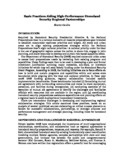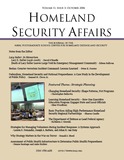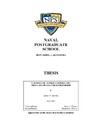Basic Practices: Aiding High-Performance Homeland Security Regional Partnerships
Abstract
One national priority under the National Preparedness Goal is collaborative geographic regional approaches. This article identifies several basic practices intended to facilitate forming and sustaining a high-performance partnership that should be useful for these collaborative approaches. These practices draw on collaboration, coordination, partnership, and performance management literature and reports. The practices are in two categories: strategic and enabling. The strategic practices value and justify the partnership. Strategic practices are (1) implementing a formal regional partnership; (2) assessing the value and content of a regional partnership on an ongoing basis; and (3) defining and articulating a common mission and specific regional partnership strategic outcomes. The enabling practices support developing, implementing, and sustaining the partnership. Enabling practices are (1) having leadership to champion commitment to a regional partnership and high-performance; (2) crafting the regional partnership's organizational infrastructure and norms to perform effectively; (3) developing joint regional strategic goals, objectives, measures, and strategies across regional jurisdictions to accomplish the strategic outcomes; (4) providing resources from both joint and individual regional partner sources to initiate and sustain the regional goals, objectives, and related strategies; and (5) setting a regional partnership performance management system for outcomes and individual performance management systems to reinforce partnerships. The practices are intended to serve as aids as jurisdictions enhance current regional arrangements or build new ones. They might be considered the base set on which to build or assess regional homeland security approaches. The article also points to additional avenues of research, such as criteria to form a geographic region, dealing with 'free rider' partners, and specific homeland security partnership skills and capabilities.
Description
This article appeared in This article appeared in Homeland Security Affairs (October 2006), v.2 no.3
Rights
The copyright of all articles published in Homeland Security Affairs rests with the author[s] of the articles. Any commercial use of Homeland Security Affairs or the articles published herein is expressly prohibited without the written consent of the copyright holder. Anyone can copy, distribute, or reuse these articles as long as the author and original source are properly cited.Related items
Showing items related by title, author, creator and subject.
-
Homeland Security Affairs Journal, Volume II - 2006: Issue 3, October
Naval Postgraduate School Center for Homeland Defense and Security (CHDS) (Monterey, California. Naval Postgraduate SchoolCenter for Homeland Defense and Security, 2006-10);October 2006. Welcome to Volume 2, Issue Three of Homeland Security Affairs. This issue is dedicated to the memory of Lacy Suiter. I believe Lacy would be embarrassed by the idea of dedicating an issue of anything to him. ... -
Homeland Security Affairs Journal, Volume V - 2009: Issue 2, May
Naval Postgraduate School Center for Homeland Defense and Security (CHDS) (Monterey, California. Naval Postgraduate SchoolCenter for Homeland Defense and Security, 2009-05);May 2009. This issue of Homeland Security Affairs opens on a sad note: Rich Cooper’s memoriam to Inspector Matthew Simeone, who passed away in March of this year. Co-president of cohort 0601-0602, Matt graduated from the ... -
COLOSSUS OF CLOSER COOPERATION: CHINA AND RUSSIA FORGE FRIENDSHIP
Merritts, Jordan T. (Monterey, CA; Naval Postgraduate School, 2023-06);In recent decades, the unprecedented degree of cooperation between China and Russia has prompted national security and foreign policy experts to question the exact nature and trajectory of the relationship. Within the ...



 62.pdf (296.6Kb)
62.pdf (296.6Kb)

